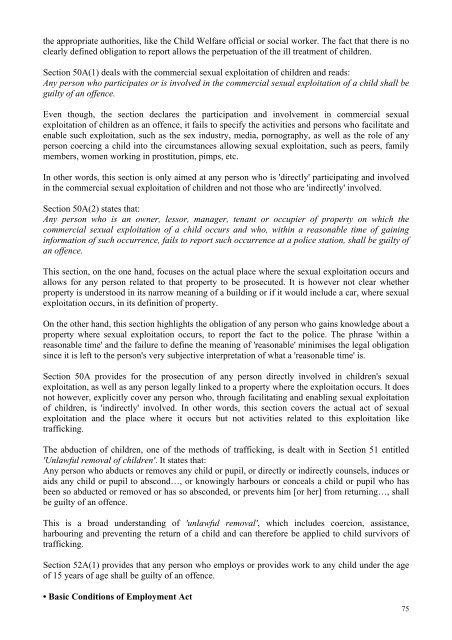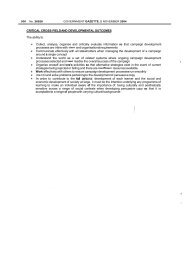The trafficking of children for purposes of sexual exploitation
The trafficking of children for purposes of sexual exploitation
The trafficking of children for purposes of sexual exploitation
Create successful ePaper yourself
Turn your PDF publications into a flip-book with our unique Google optimized e-Paper software.
the appropriate authorities, like the Child Welfare <strong>of</strong>ficial or social worker. <strong>The</strong> fact that there is no<br />
clearly defined obligation to report allows the perpetuation <strong>of</strong> the ill treatment <strong>of</strong> <strong>children</strong>.<br />
Section 50A(1) deals with the commercial <strong>sexual</strong> <strong>exploitation</strong> <strong>of</strong> <strong>children</strong> and reads:<br />
Any person who participates or is involved in the commercial <strong>sexual</strong> <strong>exploitation</strong> <strong>of</strong> a child shall be<br />
guilty <strong>of</strong> an <strong>of</strong>fence.<br />
Even though, the section declares the participation and involvement in commercial <strong>sexual</strong><br />
<strong>exploitation</strong> <strong>of</strong> <strong>children</strong> as an <strong>of</strong>fence, it fails to specify the activities and persons who facilitate and<br />
enable such <strong>exploitation</strong>, such as the sex industry, media, pornography, as well as the role <strong>of</strong> any<br />
person coercing a child into the circumstances allowing <strong>sexual</strong> <strong>exploitation</strong>, such as peers, family<br />
members, women working in prostitution, pimps, etc.<br />
In other words, this section is only aimed at any person who is 'directly' participating and involved<br />
in the commercial <strong>sexual</strong> <strong>exploitation</strong> <strong>of</strong> <strong>children</strong> and not those who are 'indirectly' involved.<br />
Section 50A(2) states that:<br />
Any person who is an owner, lessor, manager, tenant or occupier <strong>of</strong> property on which the<br />
commercial <strong>sexual</strong> <strong>exploitation</strong> <strong>of</strong> a child occurs and who, within a reasonable time <strong>of</strong> gaining<br />
in<strong>for</strong>mation <strong>of</strong> such occurrence, fails to report such occurrence at a police station, shall be guilty <strong>of</strong><br />
an <strong>of</strong>fence.<br />
This section, on the one hand, focuses on the actual place where the <strong>sexual</strong> <strong>exploitation</strong> occurs and<br />
allows <strong>for</strong> any person related to that property to be prosecuted. It is however not clear whether<br />
property is understood in its narrow meaning <strong>of</strong> a building or if it would include a car, where <strong>sexual</strong><br />
<strong>exploitation</strong> occurs, in its definition <strong>of</strong> property.<br />
On the other hand, this section highlights the obligation <strong>of</strong> any person who gains knowledge about a<br />
property where <strong>sexual</strong> <strong>exploitation</strong> occurs, to report the fact to the police. <strong>The</strong> phrase 'within a<br />
reasonable time' and the failure to define the meaning <strong>of</strong> 'reasonable' minimises the legal obligation<br />
since it is left to the person's very subjective interpretation <strong>of</strong> what a 'reasonable time' is.<br />
Section 50A provides <strong>for</strong> the prosecution <strong>of</strong> any person directly involved in <strong>children</strong>'s <strong>sexual</strong><br />
<strong>exploitation</strong>, as well as any person legally linked to a property where the <strong>exploitation</strong> occurs. It does<br />
not however, explicitly cover any person who, through facilitating and enabling <strong>sexual</strong> <strong>exploitation</strong><br />
<strong>of</strong> <strong>children</strong>, is 'indirectly' involved. In other words, this section covers the actual act <strong>of</strong> <strong>sexual</strong><br />
<strong>exploitation</strong> and the place where it occurs but not activities related to this <strong>exploitation</strong> like<br />
<strong>trafficking</strong>.<br />
<strong>The</strong> abduction <strong>of</strong> <strong>children</strong>, one <strong>of</strong> the methods <strong>of</strong> <strong>trafficking</strong>, is dealt with in Section 51 entitled<br />
'Unlawful removal <strong>of</strong> <strong>children</strong>'. It states that:<br />
Any person who abducts or removes any child or pupil, or directly or indirectly counsels, induces or<br />
aids any child or pupil to abscond…, or knowingly harbours or conceals a child or pupil who has<br />
been so abducted or removed or has so absconded, or prevents him [or her] from returning…, shall<br />
be guilty <strong>of</strong> an <strong>of</strong>fence.<br />
This is a broad understanding <strong>of</strong> 'unlawful removal', which includes coercion, assistance,<br />
harbouring and preventing the return <strong>of</strong> a child and can there<strong>for</strong>e be applied to child survivors <strong>of</strong><br />
<strong>trafficking</strong>.<br />
Section 52A(1) provides that any person who employs or provides work to any child under the age<br />
<strong>of</strong> 15 years <strong>of</strong> age shall be guilty <strong>of</strong> an <strong>of</strong>fence.<br />
• Basic Conditions <strong>of</strong> Employment Act<br />
75
















